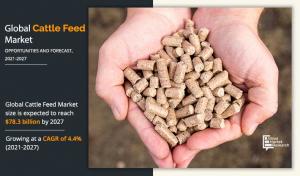Increasing populations, changing dietary preferences, and technological advancements drive market growth at a CAGR of 4.4%.
— Allied Market Research
WILMINGTON,NEW CASTLE, DELAWARE, UNITED STATES, May 13, 2024 /EINPresswire.com/ — According to a new report published by Allied Market Research, titled “Cattle Feed Market by Cattle Type and Distribution Channel: Opportunity Analysis and Industry Forecast, 2021–2027,” the cattle feed market size was valued at $73.5 billion in 2019 and is projected to reach $78.3 billion by 2027, growing at a CAGR of 4.4% from 2021 to 2027.
𝐑𝐞𝐪𝐮𝐞𝐬𝐭 𝐒𝐚𝐦𝐩𝐥𝐞 𝐑𝐞𝐩𝐨𝐫𝐭 : https://www.alliedmarketresearch.com/request-sample/A09494
The Cattle Feed Market refers to the global industry involved in the production, distribution, and sale of feed products specifically designed for cattle. Cattle feed plays a crucial role in maintaining the health and productivity of cattle, including dairy cows, beef cattle, and calves. The market encompasses various types of feed products, including forages, grains, protein supplements, minerals, and vitamins, formulated to meet the nutritional requirements of cattle at different stages of life and production.
The global cattle feed market has witnessed significant growth and is expected to continue expanding in the coming years. One of the primary drivers of market growth is the increasing demand for meat and dairy products worldwide, driven by population growth, rising disposable incomes, and changing dietary preferences. As the demand for animal protein continues to rise, the need for high-quality cattle feed to support efficient and sustainable livestock production becomes more critical.
Additionally, advancements in feed technology and formulation have led to the development of specialized feed products tailored to meet the specific nutritional needs of different cattle breeds, ages, and production systems. These innovations contribute to improving feed efficiency, enhancing animal health and welfare, and optimizing livestock performance, ultimately driving market growth.
The cattle feed market is segmented based on type, including forage, concentrates, and additives. Forage-based feeds, such as hay and silage, provide essential fiber and roughage to cattle’s diets, while concentrate feeds, such as grains and protein supplements, supply energy and protein for growth, reproduction, and milk production. Additives, including vitamins, minerals, and feed additives, are incorporated into feed formulations to enhance nutrient utilization, promote growth, and support overall animal health.
Geographically, the cattle feed market is segmented into regions such as North America, Europe, Asia-Pacific, Latin America, and the Middle East and Africa. North America and Europe are among the leading regions in terms of market share, driven by the presence of large-scale commercial livestock operations and well-established feed industries. However, Asia-Pacific is expected to witness significant growth due to the increasing demand for meat and dairy products in emerging economies such as China and India.
Key players in the cattle feed market include feed manufacturers, agricultural cooperatives, and animal nutrition companies. These companies often focus on research and development initiatives to develop innovative feed products, expand their product portfolios, and enhance their market presence through strategic partnerships, acquisitions, and investments in new markets.
𝐑𝐞𝐪𝐮𝐞𝐬𝐭 𝐟𝐨𝐫 𝐏𝐫𝐢𝐜𝐢𝐧𝐠 𝐃𝐞𝐭𝐚𝐢𝐥𝐬 : https://www.alliedmarketresearch.com/cattle-feed-market/purchase-options
The cattle feed market is poised for continued growth, driven by the increasing demand for meat and dairy products, advancements in feed technology, and the need for sustainable and efficient livestock production practices to meet the growing global food demand.
Growth in population in developing countries, such as China and India, has increased the demand for dairy products and meat products. This increase in population, coupled with per capita income, has increased the demand for meat and meat-based products, further boosting the production of animal feed and cattle feed indirectly. In emerging countries, per capita income is higher as compared to developed countries and hence, adoption of various meat and dairy products is eventually higher.
The cattle feed market is segmented on the basis of cattle type, distribution channel, and region. By cattle type, it is categorized into beef and dairy. The dairy segment was the highest contributor to the market, with $41,599.1 million in 2019, and is estimated to reach $45,305.8 million by 2027, at a CAGR of 4.6% during the forecast period. The beef segment is estimated to reach $33,077.6 million by 2027, at a CAGR of 4.0%. The fastest growth in dairy segment is attributed to the increase in demand for specific feed made for dairy cattle from dairy cattle farmers.
𝐍𝐮𝐭𝐫𝐢𝐭𝐢𝐨𝐧𝐚𝐥 𝐑𝐞𝐪𝐮𝐢𝐫𝐞𝐦𝐞𝐧𝐭𝐬
Cattle have specific nutritional requirements depending on factors such as their age, breed, production stage (e.g., growth, lactation), and environmental conditions. Feed formulations need to consider these requirements to ensure optimal health, growth, and productivity.
𝐅𝐞𝐞𝐝 𝐈𝐧𝐠𝐫𝐞𝐝𝐢𝐞𝐧𝐭𝐬
Cattle feed can include a wide range of ingredients, such as grains (corn, barley, wheat), protein sources (soybean meal, cottonseed meal), forages (alfalfa, grass hay), by-products (distillers grains, soybean hulls), and supplements (vitamins, minerals). The availability and cost-effectiveness of these ingredients can influence feed formulations and market dynamics.
𝐅𝐞𝐞𝐝 𝐏𝐫𝐨𝐜𝐞𝐬𝐬𝐢𝐧𝐠
Feed processing methods, such as grinding, mixing, pelleting, and extrusion, can affect feed quality, digestibility, and palatability. Manufacturers may utilize different processing techniques to optimize feed performance and meet the nutritional needs of cattle.
𝐑𝐞𝐠𝐮𝐥𝐚𝐭𝐨𝐫𝐲 𝐄𝐧𝐯𝐢𝐫𝐨𝐧𝐦𝐞𝐧𝐭
The production and sale of cattle feed are subject to regulatory oversight to ensure feed safety, quality, and labeling compliance. Regulatory requirements may vary by region and can impact feed formulation, manufacturing practices, and market access for feed manufacturers.
𝐒𝐮𝐬𝐭𝐚𝐢𝐧𝐚𝐛𝐢𝐥𝐢𝐭𝐲
There is growing emphasis on sustainable feed production practices to minimize environmental impact, conserve natural resources, and reduce greenhouse gas emissions. Sustainable feed sourcing, waste management, and energy efficiency are important considerations for stakeholders across the cattle feed supply chain.
𝐌𝐚𝐫𝐤𝐞𝐭 𝐓𝐫𝐞𝐧𝐝𝐬
Emerging trends in the cattle feed market include the adoption of precision feeding technologies, such as ration balancing software and precision feeding equipment, to optimize feed efficiency and reduce feed costs. Additionally, consumer demand for organic and non-GMO feed options is driving market diversification and product innovation.
𝐈𝐧𝐭𝐞𝐫𝐧𝐚𝐭𝐢𝐨𝐧𝐚𝐥 𝐓𝐫𝐚𝐝𝐞
The global trade of feed ingredients and finished feed products plays a significant role in the cattle feed market. Factors such as trade agreements, tariffs, and trade barriers can impact feed ingredient prices, supply chain logistics, and market competitiveness for feed manufacturers.
𝐑𝐞𝐬𝐞𝐚𝐫𝐜𝐡 𝐚𝐧𝐝 𝐈𝐧𝐧𝐨𝐯𝐚𝐭𝐢𝐨𝐧
Ongoing research and innovation efforts focus on improving feed efficiency, enhancing nutrient utilization, reducing environmental impact, and addressing emerging challenges in cattle nutrition and health. Collaborative research initiatives involving academia, industry, and government entities drive advancements in feed technology and animal nutrition science.
𝐄𝐧𝐪𝐮𝐢𝐫𝐞 𝐁𝐞𝐟𝐨𝐫𝐞 𝐁𝐮𝐲𝐢𝐧𝐠 : https://www.alliedmarketresearch.com/purchase-enquiry/A09494
𝐊𝐞𝐲 𝐅𝐢𝐧𝐝𝐢𝐧𝐠𝐬 𝐎𝐟 𝐓𝐡𝐞 𝐒𝐭𝐮𝐝𝐲
𝐁𝐞𝐞𝐟 𝐂𝐚𝐭𝐭𝐥𝐞 𝐒𝐞𝐠𝐦𝐞𝐧𝐭 𝐆𝐫𝐨𝐰𝐭𝐡
The beef cattle segment is expected to experience steady growth during the forecast period, with a compound annual growth rate (CAGR) of 4.0%. This growth is attributed to factors such as increasing meat consumption, rising demand for beef products, and expanding beef cattle farming operations.
𝐃𝐨𝐦𝐢𝐧𝐚𝐧𝐜𝐞 𝐨𝐟 𝐀𝐬𝐢𝐚-𝐏𝐚𝐜𝐢𝐟𝐢𝐜
The Asia-Pacific region is poised to dominate the cattle feed market share, exhibiting a robust CAGR of 5.0%. Factors driving this growth include population growth, urbanization, rising disposable incomes, and increasing demand for livestock products, particularly in countries like China and India.
𝐎𝐟𝐟𝐥𝐢𝐧𝐞 𝐃𝐢𝐬𝐭𝐫𝐢𝐛𝐮𝐭𝐢𝐨𝐧 𝐒𝐞𝐠𝐦𝐞𝐧𝐭 𝐂𝐨𝐧𝐭𝐫𝐢𝐛𝐮𝐭𝐢𝐨𝐧
The offline distribution segment is forecasted to maintain its dominance in the cattle feed market, contributing to approximately 72% of the market share by 2027. This segment is expected to grow steadily with a CAGR of 3.6% during the forecast period, driven by the widespread presence of brick-and-mortar stores, feed dealers, and Agri-input retailers catering to the needs of livestock farmers.
𝐑𝐚𝐩𝐢𝐝 𝐆𝐫𝐨𝐰𝐭𝐡 𝐨𝐟 𝐎𝐧𝐥𝐢𝐧𝐞 𝐃𝐢𝐬𝐭𝐫𝐢𝐛𝐮𝐭𝐢𝐨𝐧
The online distribution segment is projected to witness rapid growth in the global cattle feed market, with a high CAGR of 6.4% during the forecast period. This growth can be attributed to the increasing adoption of e-commerce platforms, technological advancements, and changing consumer preferences for convenient purchasing options.
𝐃𝐚𝐢𝐫𝐲 𝐒𝐞𝐠𝐦𝐞𝐧𝐭 𝐄𝐱𝐩𝐚𝐧𝐬𝐢𝐨𝐧
The dairy segment is anticipated to grow at a steady CAGR of 4.6% during the forecast period. Factors such as rising milk consumption, dairy product demand, and investments in dairy farming infrastructure are driving the growth of this segment. Additionally, advancements in feed formulations aimed at improving milk production and quality are expected to support segment growth.
These key findings provide valuable insights into the dynamics and trends shaping the global cattle feed market, allowing stakeholders to make informed decisions regarding investment, market expansion, and product development strategies.
David Correa
Allied Market Research
+1 503-894-6022
[email protected]
Visit us on social media:
Facebook
Twitter
LinkedIn
Other
![]()
Originally published at https://www.einpresswire.com/article/711039359/cattle-feed-market-to-reach-78-3-billion-by-2027-fueled-by-rising-meat-and-dairy-demand





